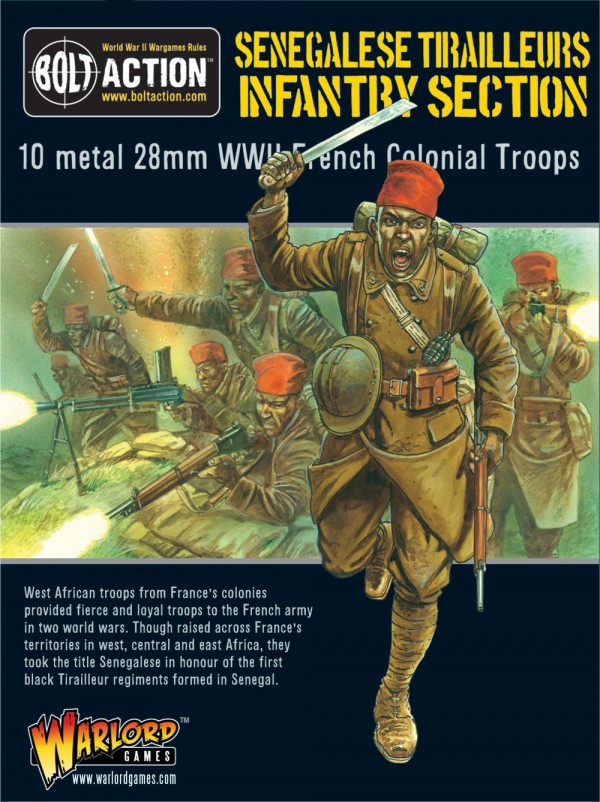With the recent release of our Senegalese Tirailleurs box set, we thought we’d shed a little more light upon some of the French Colonial troops which fought during the Second World War, with the help of Sam Phillips and Alessio Cavatore.

Senegalese Tirailleurs
The Senegalese Tirailleurs (Senegalese riflemen) were a military corps of West African colonials who fought for the French army. Recruited and conscripted from Senegal as well as West, Central and East Africa they would fight with distinction in Buzanais, Bourges, Gien and participate in the liberation of France. They were also used in many other roles, such as a police force and colonial counter-insurgency operations. They were first founded as a permanent unit of African soldiers under French rule in 1857, and were primarily used as a mercenary force consisting of slaves and Africans of lower social ranks, with some higher born Africans acting as intermediators.
The need for such a unit was apparent after the the First World War, where they themselves took part in some of the most famous battles – including the likes of the Somme. Members of the unit at this time would be conscripted and by the time of the Second World War, the French army consisted of around 9% African troops. The French army featured a good number of these units due to its heavy losses during the First World War.
Equipment
The Senegalese Tirailleurs commonly wore a khaki uniform and cap, but they would also wear the distinctive red fez. As well as rifles, the unit was armed with the coupe coupe machete, a devastating close combat weapon that was rightly feared by the enemy. They also received a mix of uniforms for France, the US and Great Britain for the French liberation in 1944.
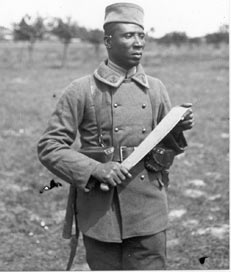
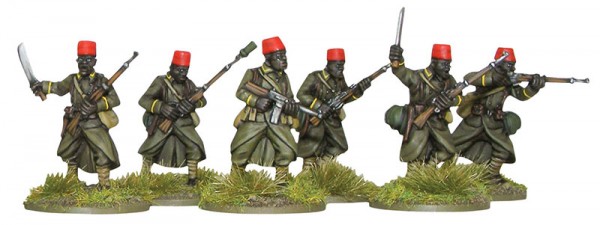
Combat History
At the Maginot Line in May and June of 1940, the French used a large portion of the Tirailleurs to defend the position. The unprepared French forces suffered a devastating blow, when the far superior and overwhelming German army – led by panzers – overran their defensive position. Many Tirailleurs were executed on the spot, or those that survived were taken prisoner and transported to the many POW camps where they suffered terribly under the Nazi racial ideology.
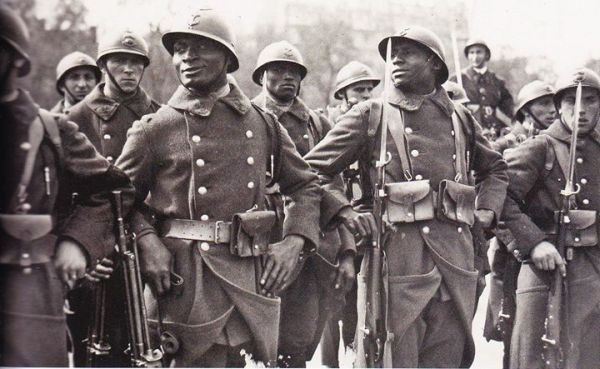
They are also famed for their actions during the siege of Bir Hakeim, amid the battle of Gazala in North Africa. The German army (under the command of Rommel) sought to take control of the old Ottoman fort, in order to secure his supply route to reinforce his main position. The allied force needed to hold this position to give them more time to recover from their previous defeat. The Senegalese fought bravely and repulsed many an attack, but the Germans assaulted the well-defended fort relentlessly over a number of days. It was only once all of their ammunition was spent that the allied force within had to make a fighting withdrawal.
They also fought in the infamous battle of Monte Cassino and the taking of the island of Elba before taking part in one of the largest invasions of the war – Operation Dragoon – the allied invasion of southern France in August 1944. Though it was largely overshadowed by the events of Operation Overlord, 70 days previously, Dragoon was a well-coordinated attack by sea and air and in which the African troops fought bravely, earning themselves a fierce reputation.
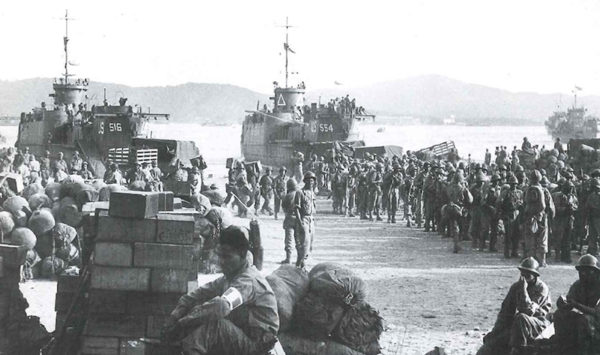
Of the 230,000 Tirailleurs fighting in WW2, around 20,000 would be killed in battle. Throughout the army many of these African soldiers were integrated into other units. However when the French victory against the Germans was close at hand, the order of whitening or bleaching (blanchiment) of the Free French forces was given by Charles de Gaulle, replacing 20,000 African soldiers with white Frenchmen. In order to achieve this, de Gaulle chose to incorporate many partisan groups within the structure of the official army.
There they struggled to obtain equality with the French on the mainland. As a result black African assimilation into the regular French army increased dramatically in the late 1940s and into the 50s. The unit would eventually shed its mercenary role and become a unit where volunteers outweighed the conscripted members, with some even reaching officer ranks.
Written by Sam Phillips
Moroccan Goumiers
The Moroccan Goumiers – or ‘Goums’ fought the Italians and Germans from 1942 – 1945, and specialised in operating in rough terrain.
The Goums first saw action against the Italians in North Africa – after which they were returned to Libya where they undertook Gendarm tasks such as maintaining public order and performing surveillance operations on the frontiers.
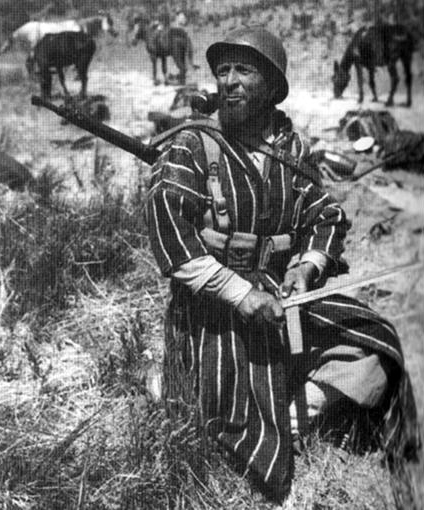
They were later assigned to Tunisia, where they fought alongside the British before taking Bizerte and Tunis. The Goums fought with such ferocity that the French army then re-organised the Goums into two new units – each numbering around 4,000 men.
During the invasion of Sicily, one Goum unit was attached to the US Seventh Army and were again commended for their courage during the heat of battle – with many Italian units simply surrendering at the sight of the Guoms, while the Germans fought a retreat.
Though the Guoms were reknowned for their fighting spirit, they were not free from controversy – with horrific reports of multiple atrocities – unlawful killings, rape and pillaging were reported right across Italy – leaving an indellible mark upon their military record.
Chasseurs Alpins
The Chasseurs Alpins were (and indeed still are) an elite fighting force of the French army – having been specially trained for mountainous terrain and close-quarters combat.
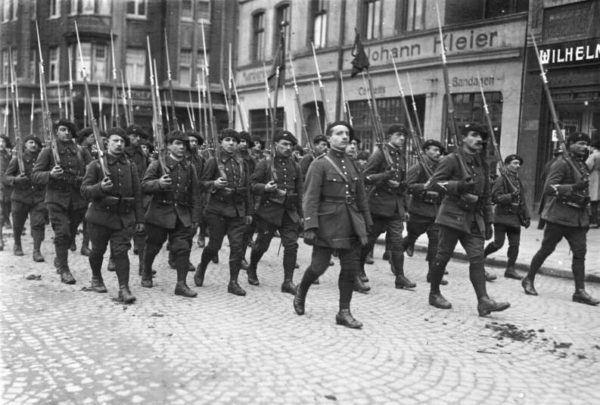
The unit was established back in the 1800s when Italy became a unified state. The French feared invasion through the Alps – particularly because the Italian army had recently begun training their own specialist mountain troops – the Alpini.
They wore a plain and practical uniform designed to be suitable for mountain service – a loose-fitting dark blue jacket and blue-grey breeches, together with a large beret carrying the yellow bugle horn insignia of the Chasseur branch. They are widely believed to have been the first regular military unit to have worn this form of headdress.
Perhaps the most notable military action of the Chasseurs Alpins was during the battles of Narvik – where they clashed with German Gebirgsjager amid the frigid mountains surrounding the Norweigan harbour town.
French Mountain Troops
The selector below allows you to field a force of French Mountain Troops, whether it’s the Alpine Chasseurs, mostly active in the early war on the Italian front or the colonial light infantry (Tirailleurs from central Africa and North African Goumier, for example) who saw action in North Africa and later in the Italian campaign, playing an important part at the battle of Monte Cassino and in the taking of the Elba island.
A French Mountain Troops force must comprise one or more Reinforced Platoons picked from the following theatre selector. Each Reinforced Platoon is made up as follows:
French Mountain Troops Reinforced Platoon
1 Lieutenant – First or Second
2 Infantry sections – Group Franc/SES/GIA Veteran Infantry sections, or Senegalese Tirailleurs sections or Moroccan Gourmier sections.
plus:
Headquarters
0-1 Captain or Major
0-1 Medic team
0-1 Forward Observer (either Artillery or Air)
Infantry
0-4 Infantry sections: Group Franc/SES/GIA Veteran Infantry sections, Senegalese Tirailleurs Infantry sections, Moroccan Gourmier sections.
0-1 Machine gun team
0-2 Sniper team
0-1 Flamethrower team (taken from the US flamethrower team entry on page 150 of the BA rulebook)
0-1 Mortar team: light or medium
Artillery
0-1 gun from:
Field Artillery: light artillery
Transports and Tows
0-1 Mule team (see below)
Special Rules – Mountaineers
All infantry units in this list, and the Mule team (even when ‘towing’ artillery), treat all rough ground as open ground. The players should discuss and agree before the game if the gaming table includes some terrain that they think this rule should not apply to, like water features and other terrain elements that obviously mountain troops would have no advantage in crossing.
Mule Team
Throughout the ages, mules have proved to be a reliable method of transport. In World War II mules continued to serve all armies in this role, assisting in moving equipment, munitions and wounded soldiers through mountain and jungle terrain.
They are treated as a towing vehicle, except that they move as infantry.
Cost: 4 pts (Inexperienced), 5 pts (Regular), 6 pts (Veteran).
Weapons: none.
Damage Value: 3+ (literally soft skinned)
Tow: Any light gun or light howitzer
Special Rules:
• Stubborn. When taking an order test and doubles are rolled, the mules become stubborn and refuse to cooperate even if the order test was passed. Place the order dice to Down and add 1 pin marker to the team. This rule does not apply if Fubar is rolled.
• Gun assembly. To simulate the fact that the gun was actually transported disassembled, when the gun is unlimbered the artillery unit suffers a pin. When the gun is limbered, the mules team (and consequently the ‘transported’ artillery unit) suffers a pin.
